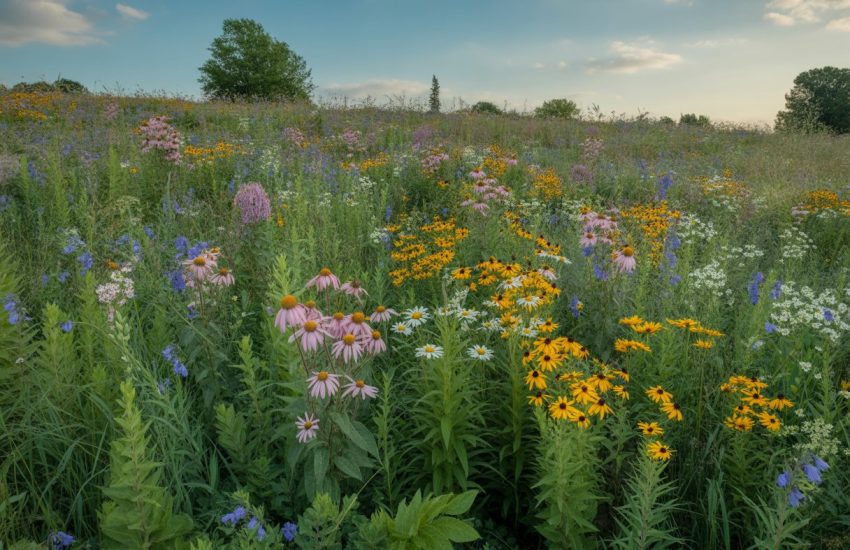Common Problems with Blazing Star and Solutions for Healthy Growth and Maintenance
Blazing star, or liatris, is a native favorite with its tall, spiky flowers and undeniable charm. It fits in beautifully across many gardens, but honestly, it’s not without a few headaches.
Understanding what can go wrong helps you keep those blooms looking their best. Let’s dig into the most common blazing star problems and how to tackle them.
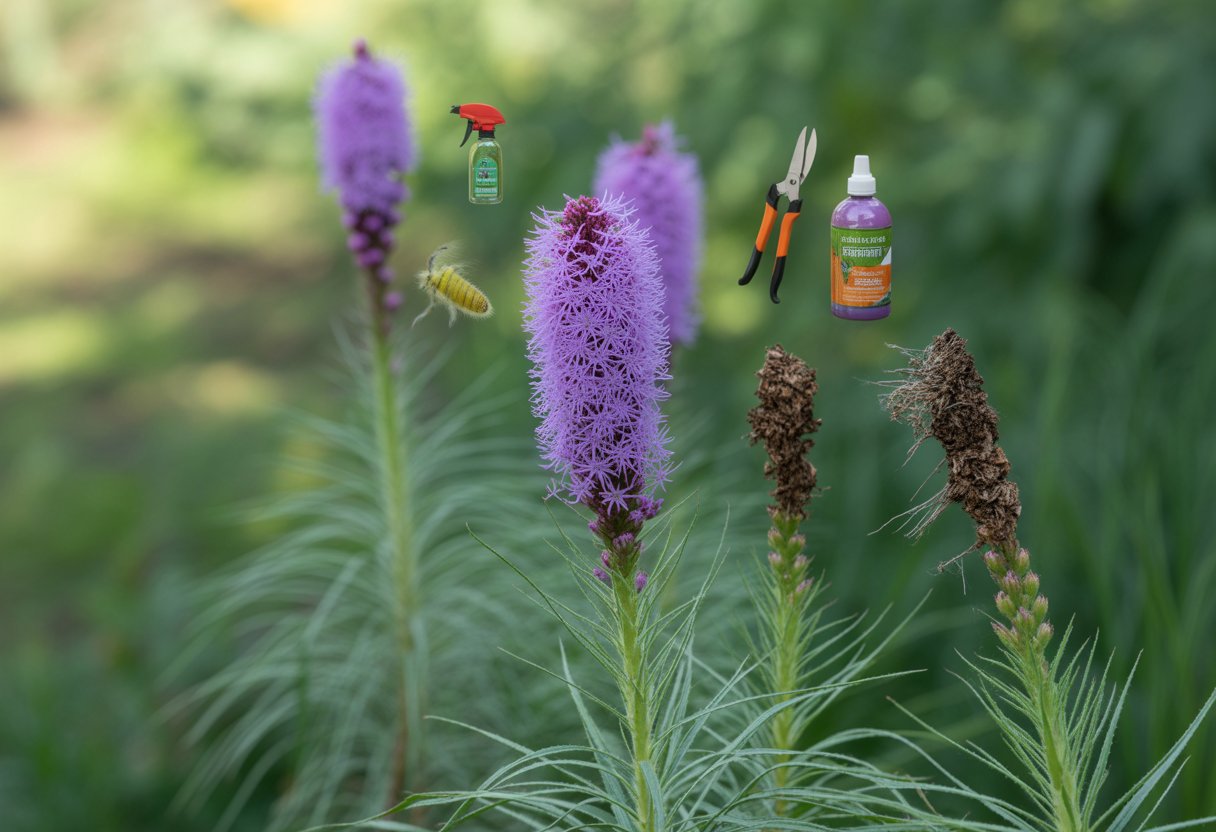
You’ll mostly run into fungal diseases, poor drainage, or pest issues. The good news? You can usually fix these by tweaking your soil, watering smarter, and staying a step ahead with prevention.
Blazing star can show symptoms that look like other plants’ problems, so knowing what makes it tick—and what it’s called—makes troubleshooting way easier.
Key Growing Challenges for Blazing Star
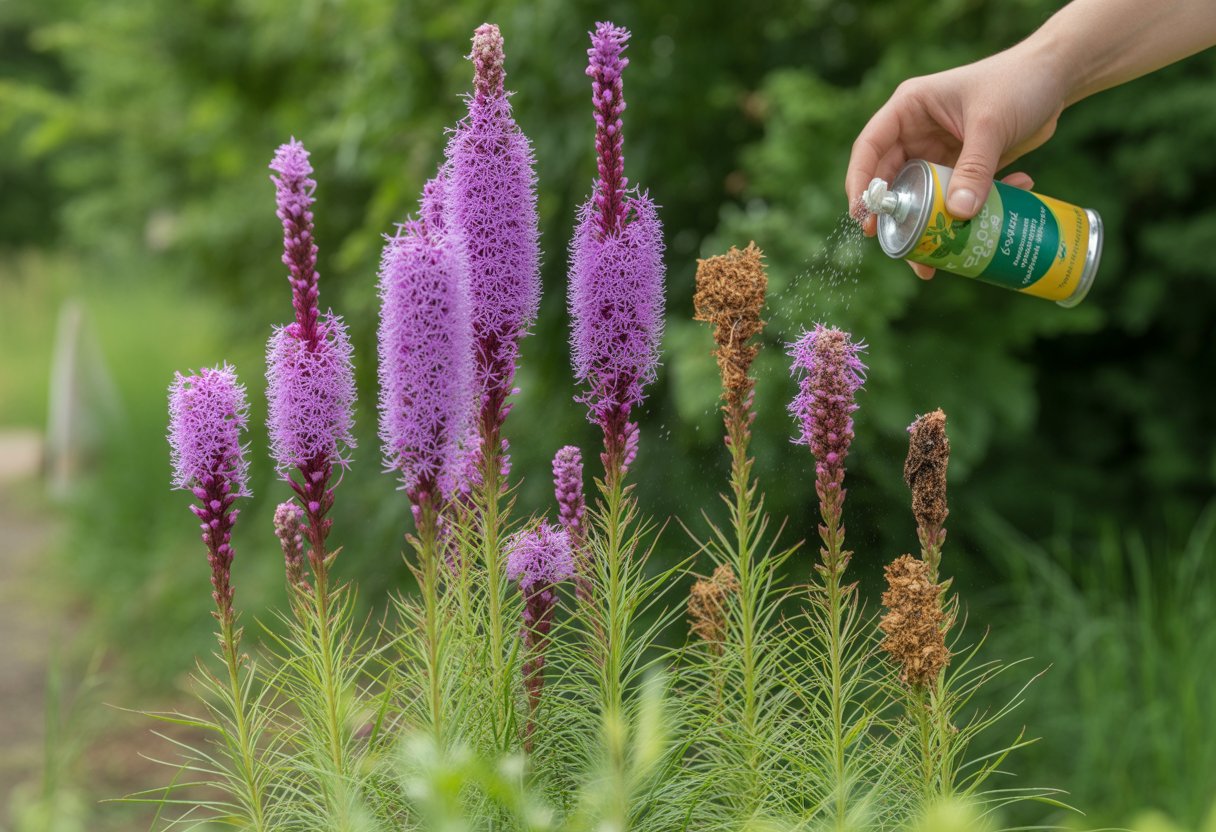
Blazing star (Liatris species) likes things a certain way. Most issues come down to soil, light, water, or nutrients.
Get those right, and you’ll see healthier plants and much better flowering.
Soil Requirements and Drainage
Blazing star really prefers well-drained soil—sandy loam is ideal, but it’ll put up with clay or limestone if you’re careful. If your soil holds water, you risk root rot.
Mixing in compost helps the soil breathe and keeps it from turning to muck. That way, roots get enough moisture without drowning.
If you’re working with heavy clay, it’s often better to amend it or just go with raised beds. Aim for a soil pH around 6.0 to 7.0 for best results.
Light Exposure and Temperature Needs
Blazing star needs at least 6 hours of full sun. Too much shade leads to floppy stems and fewer flowers.
It’s built for temperate North American climates, so it can handle a lot, but extreme heat or cold can throw it off. Daytime temps between 65°F and 85°F are its sweet spot.
If you can, put it somewhere with decent air movement. That helps it cope with stress.
Watering Practices and Moisture Management
Once it’s settled in, blazing star handles drought pretty well. But in the early days, it needs regular watering.
Overwatering is a classic mistake—roots can rot fast if they’re always wet. Water deeply, but let the soil dry out between sessions.
If your soil stays soggy, you’ll see problems with vigor and root health. Less is often more.
Nutrient Deficiencies and Fertilization
Blazing star isn’t fussy about rich soil, but a little fertilizer doesn’t hurt. Not enough nitrogen makes leaves pale and growth weak.
Phosphorus helps roots and flowers, so don’t skip it. A balanced, slow-release fertilizer in early spring usually does the trick.
Skip the high-nitrogen stuff—too much leaf, not enough bloom. Adding compost every year keeps the soil lively and feeds the plant naturally.
Pest and Disease Issues
Blazing star (Liatris spicata) can run into trouble with fungi and bugs. Spotting problems early and acting quickly helps keep plants strong.
Powdery Mildew and Root Rot
Powdery mildew shows up as white, powdery spots on leaves and stems, especially in crowded, damp spots. It loves humidity and poor airflow.
You can avoid most mildew by giving plants space and skipping overhead watering. Root rot comes from soggy soil or too much water.
If you see yellowing leaves and wilting, even when the soil is wet, check your drainage. Letting water drain away keeps roots healthy.
Common Pests Affecting Blazing Star
Aphids, spider mites, and leafhoppers like to snack on blazing star. They suck sap, which causes leaf discoloration, weird growth, or stunted growth.
Keep an eye out and catch infestations early. Encourage good bugs, and only use insecticidal soap if you really need it.
Cutting off infested stems and keeping plants healthy goes a long way. Sometimes, less intervention is actually better.
Environmental Stress-Related Diseases
When blazing star gets too much or too little water, or lacks nutrients, it’s more likely to get sick. Stressed plants can’t fight off diseases as well.
Stick to a steady watering and feeding routine. Mulch helps even out soil temperature and keeps moisture in check, which eases stress.
Blooming, Maintenance, and Ornamental Value
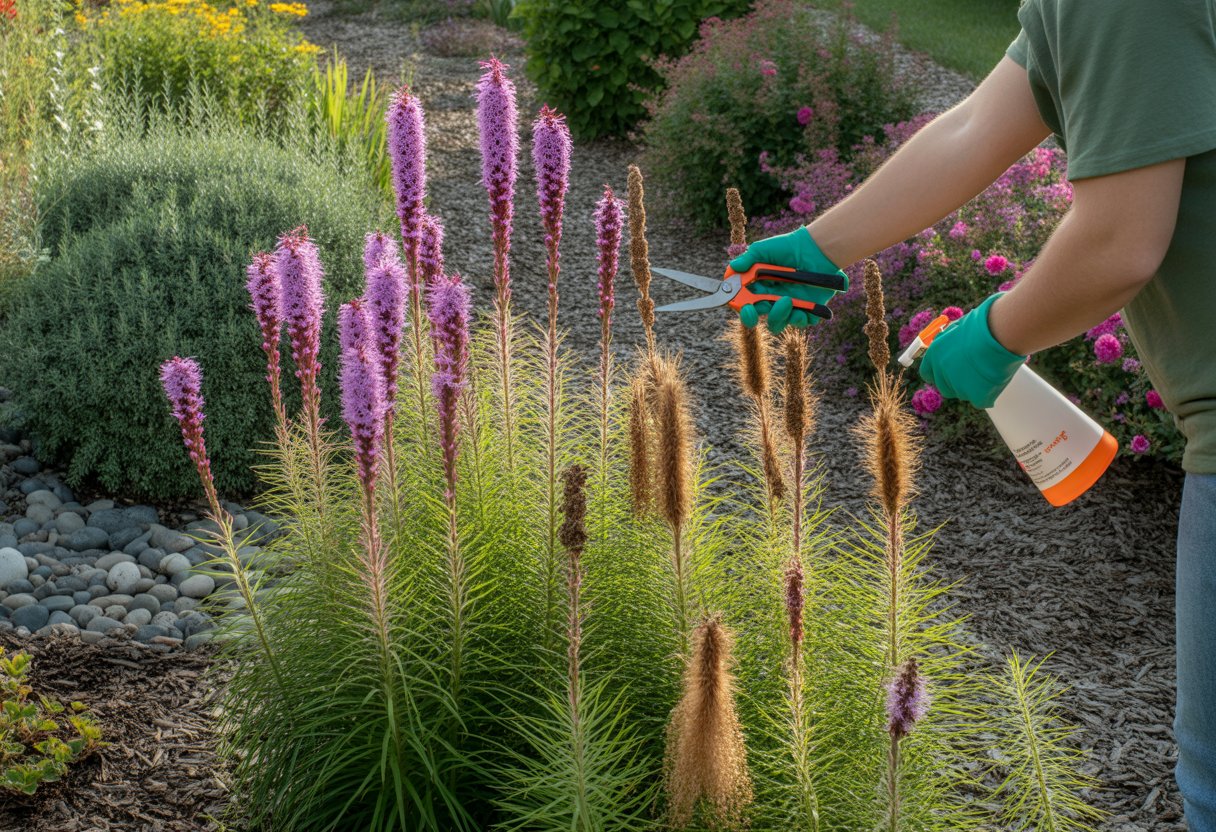
Blazing star brings vertical drama and eye-catching flower spikes. The right care keeps it blooming and looking good.
You’ll find all sorts of cultivars, so there’s something for almost any garden or bouquet.
Blooming Season and Flower Spikes
Blazing star (or gayfeather) puts on its show from mid to late summer. Its spikes can hit 3 to 5 feet, drawing in butterflies and bees.
Flowers come in purple, pink, or white—sometimes all on one plant. Blooms can last a good 4 to 6 weeks, depending on weather.
If you want the most flowers, give it plenty of sun. Shade really cuts down on the bloom count.
Pruning, Deadheading, and Cutting Back
Deadheading keeps flowers coming and stops the plant from spreading seeds everywhere. Snipping off spent spikes keeps things tidy, but you might miss out on seedheads.
Cut the plant back to the ground in late fall or early spring for a fresh start. This also helps avoid diseases and winter damage.
Blazing star doesn’t need much fuss. Just prune occasionally and pull off dead leaves to keep it looking sharp.
Cultivars, Mass Planting, and Garden Uses
With so many cultivars, you can pick by height, color, or bloom time. ‘Kobold’ is great if you want something shorter, while ‘Pride of Illinois’ towers over the rest.
Planting a bunch together gives you a big punch of color and height in borders or cottage gardens. It also looks awesome with ornamental grasses.
Those sturdy spikes hold up well in vases, too. They’re a favorite for cut flower arrangements because they last and have a cool, architectural vibe.
Supporting Pollinators and Wildlife
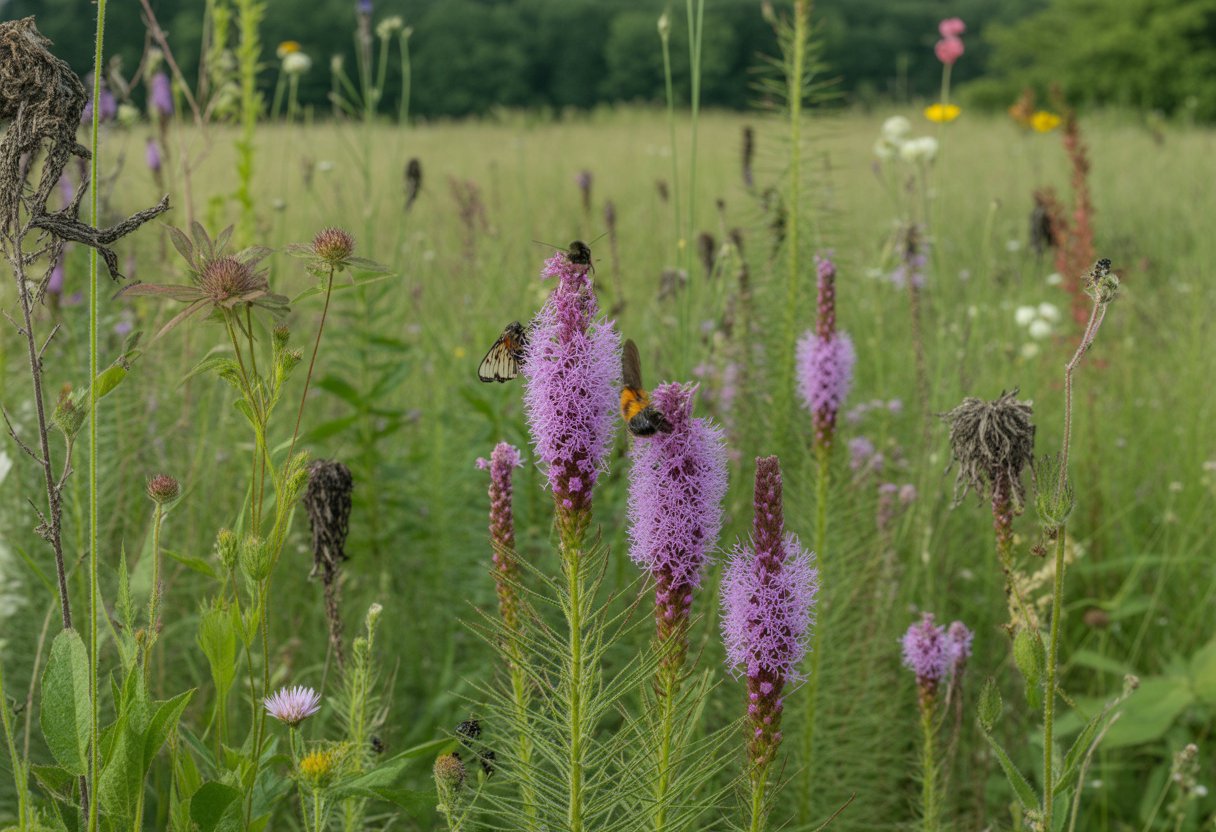
Blazing star isn’t just pretty—it’s a lifeline for pollinators and wildlife. It offers nectar, shelter, and fits right in with other native plants.
That’s a big win for anyone who wants more butterflies and bees in the yard.
Attracting Butterflies, Bees, and Hummingbirds
Butterflies like monarchs, tiger swallowtails, and painted ladies flock to blazing star for its nectar. They need it during migrations and breeding.
Bees—both wild and honeybees—visit the blooms constantly. The dense flower spikes make it a pollinator magnet.
Hummingbirds can’t resist the bright flowers either. Blazing star’s bloom time fills the gap after spring flowers fade, keeping the buffet open.
Blazing Star in Pollinator Gardens
Plant blazing star in sunny, well-drained spots for best results. It mixes well with goldenrod, baptisia, and partridge pea for longer bloom seasons and more pollinator action.
Adding it to meadows or wildflower mixes layers in habitat and food sources. It’s a simple way to boost biodiversity, especially during Wildflower Wednesday events or just because you love native plants.
Don’t overwater—root rot is always lurking if things stay wet. Deadhead regularly to stretch out the bloom time, which keeps pollinators coming and brightens up the garden a bit longer.
Interactions with Other Native Plants
Blazing star sits in the asteraceae family. It pairs well with wildflowers that like similar conditions.
You’ll often find it supporting pollinator networks, drawing in insects that also flock to goldenrod and spring ephemerals. That creates a pretty resilient native plant community, if you ask me.
When it blooms alongside baptisia or partridge pea, you’ll see more diverse pollinator visits. Silver-spotted skippers and sulphurs seem especially fond of this mix.
This blend of species helps avoid too much pollinator competition. It keeps local ecosystems steadier, which is always a good thing.

